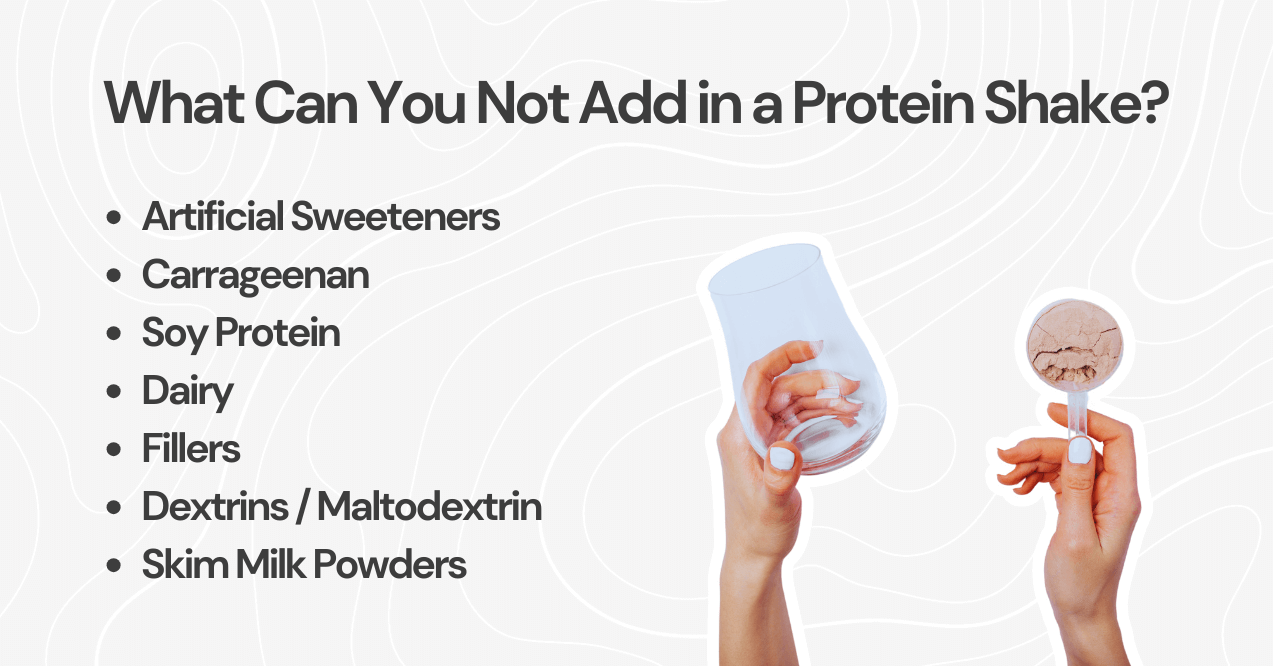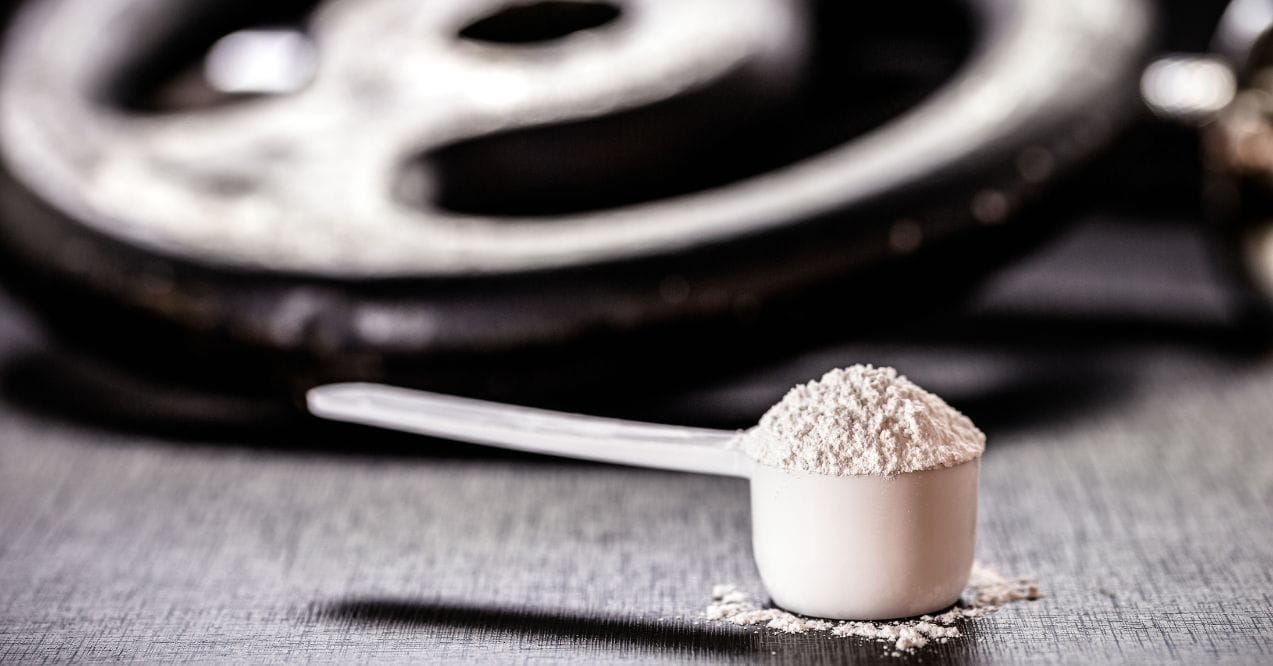What Can You Not Add in a Protein Shake? Common Mistakes to Watch For
Knowing what can you not add in a protein shake is just as important as knowing what to include. Protein shakes are a popular choice for those looking to support their fitness and health goals. They’re an easy way to boost your protein intake.
But adding the wrong ingredients can reduce the benefits or bring in unnecessary extras your body doesn’t need. In this blog, we’ll explore the ingredients you should avoid, ensuring your protein shake remains a clean, effective boost to your routine.
Key findings:
What can you not add in a protein shake?

When crafting your ideal protein shake, it’s important to know what can you not add in a protein shake to keep it effective and beneficial. Including certain ingredients can hinder your fitness goals or affect your health in unintended ways.
One key factor to consider is protein content per serving. If you’re wondering how many protein g in one protein scoop, it typically ranges from 20-30 grams, depending on the type and brand of protein powder. Many people assume that adding extra scoops of protein powder leads to better muscle growth, but How Much Protein Can Your Body Absorb? While it varies by individual, research suggests that the body efficiently processes 20-25 grams of protein per meal for muscle protein synthesis. Consuming significantly more in one sitting may not necessarily provide extra benefits and could instead be stored as energy or excreted. To maximize protein utilization, it’s best to distribute intake evenly throughout the day.
1. Artificial sweeteners
Artificial sweeteners might seem like a good choice since they add sweetness without extra calories. However, they can negatively impact gut health and metabolism. Some studies suggest that these sweeteners may also alter the balance of gut bacteria, potentially leading to digestive discomfort. Opting for natural sweeteners like honey or maple syrup, in moderation, can be a better alternative.
2. Carrageenan
Carrageenan is often used as a thickening agent in protein shakes and other beverages. While it enhances texture, it has been linked to digestive issues and may contribute to inflammation in the gut. Choosing a protein shake without carrageenan can help you avoid these potential problems. Always check the ingredient list to ensure your shake is free from this additive.
3. Soy protein
Though soy protein is popular in plant-based shakes, it comes with concerns. Some research points to its potential effects on hormone levels, while others highlight the risk of allergenic reactions in some individuals. If you’re questioning can you drink protein shakes without working out, be mindful that the type of protein you choose matters, and soy may not be the best fit for everyone.
4. Dairy
Including dairy in your protein shake may seem like a good idea, but it can cause problems for some. Full-fat milk or cream can lead to digestive discomfort, especially for individuals who are lactose intolerant or sensitive to dairy. Even if you’re not lactose intolerant, heavy dairy products can make your shake harder to digest and may cause bloating or gas.
5. Fillers
Many protein powders include fillers to bulk up the product, but they don’t add any nutritional value. These fillers, often listed as “protein blends” or vague ingredients, can lower the quality of your shake. They can also lead to bloating or discomfort after consumption. For a cleaner shake, choose products that are free of unnecessary fillers.
6. Dextrins / Maltodextrin
Dextrins and maltodextrin are common additives in protein powders, used as thickeners or fillers. While they might improve texture, they’re highly processed and can cause spikes in blood sugar, making them a poor choice for some. These additives offer little nutritional value and may be best avoided if you’re looking for a balanced shake that supports stable energy levels.
7, Skim Milk Powders
Skim milk powders are often used in protein shakes as a lower-fat dairy alternative, but they come with downsides. These powders are highly processed and lack the same nutritional benefits as fresh dairy or plant-based milk. For those looking to maximize the health benefits of their protein shake, fresh milk alternatives are a better option.
What to mix protein powder with?
Knowing what to mix protein powder with can make all the difference in reaching your health goals. The liquid you choose depends on your dietary preferences and desired results. Here are three popular options:
Water
Mixing protein powder with water is simple, low-calorie, and easy to digest. It’s ideal for those avoiding extra calories or dairy, making it a great choice for weight loss or lactose sensitivity.
Milk
Milk adds extra protein, fats, and carbohydrates, making your shake creamier and more filling. It’s a good option if you need more calories, especially for post-workout recovery.
Smoothies
For a more nutrient-dense option, blending your protein powder into a smoothie is an excellent idea. You can mix in fruits, vegetables, and other ingredients like collagen and bone broth together or even a protein powder for almond flour to create a meal replacement packed with vitamins, minerals, and fiber. Wondering how much collagen is in bone broth? Adding bone broth supplements to a smoothie gives an additional protein boost, making it a versatile base for your shake.

You can easily boost your protein shake’s nutritional value with trumeta Bone Broth Protein. Tested at 98% purity, it delivers a clean, high-quality source of protein with no fillers or fluff. Made from meaty beef bones, it’s packed with over 30 amino acids, vitamins, and minerals, providing a powerhouse of nutrition.
The powder is convenient and comes in a delicious all-natural cocoa flavor, making it a perfect addition to your shake. Whether you’re mixing with water, milk, or blending into a smoothie, trumeta bone broth protein supports your goals with rich, whole-food protein.
Conclusion
To keep your protein shake nutritious, avoid ingredients that may reduce its benefits. Stay away from artificial sweeteners, carrageenan, soy protein, and fillers, as they can lower the shake’s quality. Choosing clean ingredients ensures your shake supports your health goals, whether you mix it with water, milk, or blend it into a smoothie.
Yes, you can mix protein powder with water. It’s a quick, low-calorie option that keeps your shake simple. Water helps you avoid extra calories from dairy or other liquids, making it ideal for weight management.
It depends on your goals. Water keeps calories low, while milk adds extra protein, fats, and carbs. Milk creates a creamier texture and is great for those needing more calories or nutrients after workouts.
Carrageenan is linked to digestive discomfort and inflammation in some individuals. Avoiding it in your shake can help prevent potential gut issues, promoting a cleaner, easier-to-digest protein drink.
Advertisement. This site offers health, wellness, fitness and nutritional information and is designed for educational purposes only. You should not rely on this information as a substitute for, nor does it replace, professional medical advice, diagnosis, or treatment. If you have any concerns or questions about your health, you should always consult with a physician or other health-care professional. Do not disregard, avoid or delay obtaining medical or health related advice from your health-care professional because of something you may have read on this site. The use of any information provided on this site is solely at your own risk.







